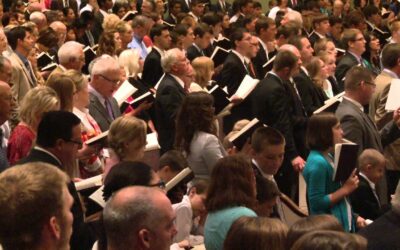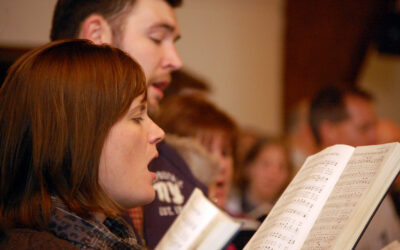Traditional worship that is effective and meaningful will naturally focus itself around a central theme. In order to effect a thematic approach all of the elements must point in the same direction. To achieve this goal both the music and message must match. In this blog post I hope to present the reason for matching music and message and offer suggestions on how to make it happen.
In the best practices of traditional worship the service of worship should be held together by adherence to a central theme. Each part of the worship should flow from one part to another but all parts should allude to or relate to a theme. While each part should play its own unique role in the service care should be taken to ensure that each part fits or connects with all the other parts. In many respects this “connectivity” in worship is similar to all the pieces of a jigsaw puzzle. When you’re looking at each individual piece it’s hard to tell what the big picture is or how the single piece fits into the whole. But once you get all the pieces of the puzzle to fit together you can step back and see the beauty of the entire picture. This is what we’re trying to do when we are matching music and message in worship. We’re trying to talk all those unique puzzle pieces and put them together in the right order rather than forcing them into the wrong positions and wondering why the puzzle doesn’t look like the picture on the box. In the best practices of traditional worship each part of worship, each jigsaw puzzle piece, will support every other part, each part will lead logically from one to the next, and all the pieces, even though they’re different, will ultimately be in the same character.
We create this idea of matching music and message by committing ourselves to a central theme in worship. That theme is determined by the scriptures that are selected to be read and the sermon that will be preached. The music, then, supports or amplifies that central theme. The hymns you select for that day should support or amplify the scripture and sermon texts. The anthems (if you have a choir) will amplify or support the scripture and sermon texts. The voluntaries performed by vocal soloist, organ, piano, or other instrument should be music that supports or amplifies the scripture and sermon texts. The goal is to make all the elements of worship—music & message—cohesive. Everything—the sermon, the scripture readings, and the music—melds together like a jigsaw puzzle.
The first step to make music and message match is to build a worship planning team. All of the chief players—the worship leaders—must be a part of the team. They must gather at a round table where all are equally welcomed to share their expertise. The goal is to create worship that is cohesive, connected, holistic, and seamless. Teamwork is required to make this happen. Sometimes this teamwork is effortless. Other times it isn’t all that easy. Regardless of the difficulty, when you put the work in, the outcome of a thematically unified service of worship where music and message match creates a moving encounter with The Holy for all involved. In order to make this happen you must understand that while there are likely multiple players on the team, there are two roles. For the most part the pastor is going to select the scriptures from which the theme and the sermon will be developed. The musicians are going to select the music that supports or amplifies the theme.
I see four steps that a team must agree upon before effective and transformative worship planning can occur. The first step is an agreement of mutual respect. There must be respect for the unique discipline and experience of each individual. All must agree that each player on the team, regardless of their role, brings a necessary and disciplined perspective to the table. Each individual’s area of expertise is the gift they bring to the team. One team member may have a great idea, but another team member will know HOW to implement that great idea. The more a team works together the more trust will develop. Once you have mastered respect and trust you have a team that will succeed.
The second step must be buy-in by all the players to the commitment to make message and music match. The team will not work if each person does their own thing. All team players must agree that they want the worship service to have matching music and message, and that the worship service must fit together like a jigsaw puzzle. This will require discipline and constant reminders. No one—the pastor and the musicians—can do their own thing. All the players must work together to buy-in to the goal of matching music and message.
The third step is an agreement on the definition of worship. Everyone must come to the round table with the same understanding of worship. Worship is a dialogue between The Creator and His created. Any other purpose or goal, no matter how worthy or valuable, is not worship. To help achieve this unified understanding I’ve created a free mini course “The 6 Core Components of Traditional Worship.” Browse toward the bottom of the website (SacredSongConsulting.com) and sign up. Every day for eight days you will get one four-minute video that explains the 6 core components of traditional worship. This simple instruction sequence will help you and your team understand the purpose of worship.
The first three steps have all addressed more philosophical issues of worship planning. Step four is more practical and straight forward: all worship team members must plan ahead—a minimum of TWO MONTHS ahead. For some this idea of planning two months out will be jaw dropping! Anything worth doing requires preparation. The more people involved the more preparation, both corporate (the worship planning team) and personal (each member of the worship planning team). Since the pastor selects the theme (scriptures and sermon) the pastor must start the ball rolling. It takes time for the pastor to select scriptures, develop a theme, provide an outline for the sermon, research, study, pray, and prepare. The musicians can’t do their jobs properly until the pastor decides the theme—scriptures and sermon. The musicians, then, must search the repertoire for literature (hymnody, choral literature, solo literature, etc.) that supports or amplifies the theme. Sometimes this is an easy process, other times it is excruciatingly lengthy and arduous. If the music needed to support or amplify the theme is not available in the church’s music library, it must be ordered. There will be, then, a length of time between selecting the appropriate literature and its arrival on site. But once the literature is secured there is still the lead time required to learn and practice the music. A typical church choir should plan on 4-6 weeks of rehearsal for one anthem before it is offered as an act of worship in a Sunday morning service. You can already see why the worship team should be planning a minimum of 2 months out! This two-month lead time doesn’t mean everything must be ready to go two months out. It just means that you know the direction you are going. The pastor will perfect the sermon in the week leading up to a given service but will have an outline or overview of the sermon two months out. Is two months out enough time? No! It should be much more! Two months is a minimum.
A frequent comment I hear regarding the minimum of two months lead time is something akin to “I wait for the Sprit to lead me—on Saturday night!” With all due respect, the Spirit, if we are listening, will inspire us weeks, months, and years ahead. Waiting until Saturday night to “hear the spirit” is procrastination. Our God is worthy of our best efforts in leading His people in worship. We cannot accomplish this if we are ill prepared.
With this four-step preparation under our belts it’s time to focus on what the team does in planning worship. For the pastor, nailing down the scriptures and sermon topic is the starting point. To be effective the pastor must provide the musicians with a summary of the sermon as well and, ideally, provide the musicians with a hymn that summarizes the sermon. Since musicians think musically (and specifically roll over in the minds known literature as they think) providing them with a summarizing hymn is of enormous benefit. Doing so solidifies the musician’s understanding of the theme.
For the musicians, then, they will select hymns, anthems, and other music based on a number of criteria. There may be a perfect anthem to fit the theme but it may be too difficult for the choir. There may be a great hymn appropriate for the theme but if it isn’t known by the congregation they will not sing and thus this imperative act of worship becomes a waste of time. But once the musicians have selected the music they should give it to the pastor. The pastor then reviews the music, not to approve or disapprove (the pastor must trust and respect the musicians) but rather to use the music to “season” the sermon. The pastor should seamlessly weave into the sermon a quote—a line of text—from a hymn or anthem used in the worship service. Doing so helps match music and message and tells the congregation clearly that there was effort extended. It also reinforces the message. But musicians, make sure you select music for its content, NOT its style or emotional affect. Content is king. Gimmicks in music draw attention to themselves rather than to the message. Choose wisely!
Once the music and message are matched stick with your choices. Just like young teachers are taught, plan your work and work your plan. Do what it takes to plan worship (regardless of how much or how little effort it may take) and then stick with what you’ve planned. There are occasions where a worship plan has to be amended, but these occasions should be rare exceptions. If the modus operandi of worship leaders is frequent last-minute changes the team is planning poorly. The team must be disciplined about its planning and implementation. Plan your work and work your plan.
_______________
Sacred Song Consulting exists solely to help congregations refine, revitalize, and reform traditional worship for contemporary people. We are a resource for all worship leaders. We are a guide to lead you to the best practices of traditional worship. We provide you with the tools to plan, prepare, and lead traditional worship, the nuts-and-bolts concepts that help traditional worship honor God and enrich the congregation. We are here to help you! You are not alone in your desire to have transformative worship in your congregation. Reach out to us. Let us know how we can help you!



0 Comments